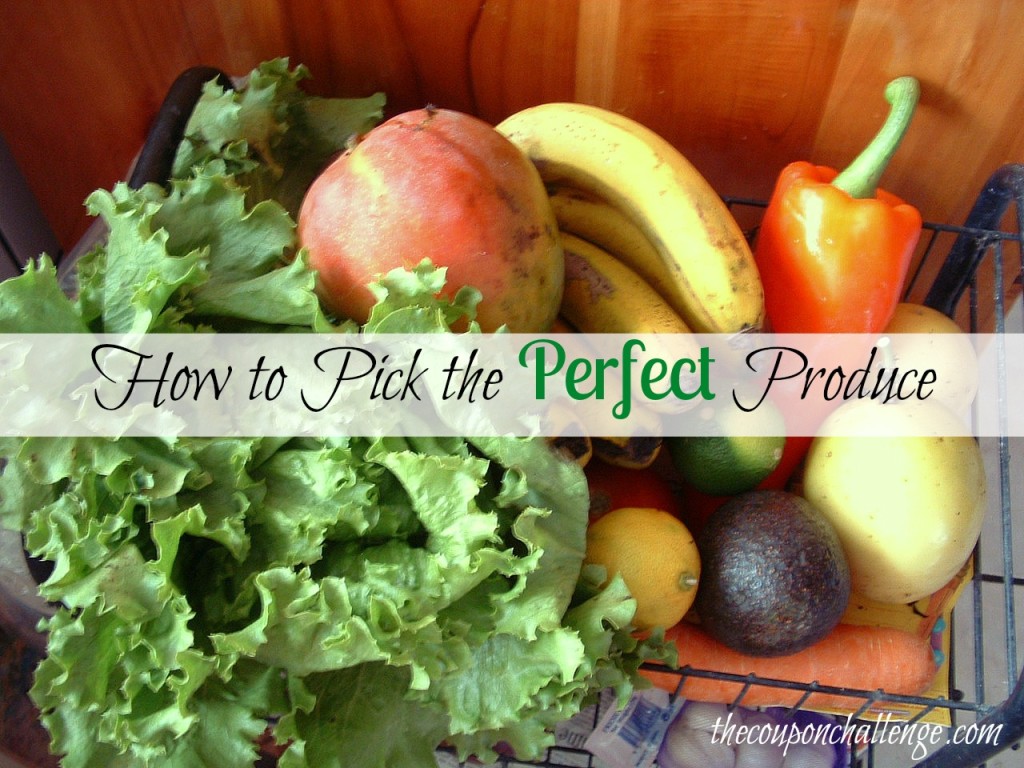
{Pin It}
One way to save money at the grocery store is to ensure that produce is bought at the optimal time in relation to when you want to use it. Not only is it important to know how to determine ripeness for different types of produce but it is also necessary to know which types of produce will continue to ripen once picked.
Below is a summary including advice on evaluating 20 different types of produce, so you can learn how to pick the perfect produce.
1) Cantaloupe should feel heavier than it looks when it is ripe. The smell will be sweet and musky but not overly sweet. If it smells too sweet, it is probably over ripe. Lastly take a look at the stem to be sure that there is no lip present. If you do purchase a cantaloupe that is not ripe, you can leave it on the counter to ripen over time.
2) Pineapple will be firm to the touch when ripe and will smell sweet. If the pineapple smells like vinegar it is over ripe and if it smells like nothing, it needs to ripen more. The entire pineapple will be a golden brown color without any lingering green color at the base. Lastly if you try to pluck a leaf from the top and it comes out easily, the pineapple is ripe.
3) Strawberries should be completely red. If the green color is present at the top/stem, it means that the strawberry is not fully ripe. Ripe strawberries will smell distinctly sweet. Always look at the bottom of the container for any signs of mold or fermentation.
4) Mangos have different varieties so you should be familiar with the kind you want in order to determine if it is ripe. A ripe mango will always smell sweet especially near the stem where the smell will be the strongest. A mango will be soft when it is ripe and it will feel heavier. Mango will continue to ripen after being picked but do not refrigerate if the mango needs to ripen further.
5) A ripe watermelon will sound hollow when tapped and will feel heavy because it is full of water. The field spot (the space near where the watermelon was picked from the stem) should be yellow instead of white. Melons don’t continue to ripen once picked so don’t store them with fruit that do continually ripen such as apples and bananas.
6) The corn husk should be green and moist and the silk will be moist and cling to the corn. Kernels will look plump and full. Keep an eye out for any rotted or missing kernels.
7) Pumpkins should sound hollow and the skin should be a hard shell which cannot be punctured by a fingernail. The vine should be dead and brown.
8) Avocados should be firm and the stem color will be a yellow green color. If it has turned brown, it is overripe. You can leave an avocado out and it will ripen.
9) The skin of an eggplant should be free from blemishes. The stem and gap should be bright green while the body should be deep and dark purple.
10) Tomatoes should be glossy and give slightly when squeezed. Be sure you are aware of the type of tomato you are looking at before you judge by color because not all tomatoes are red when fully ripe.
11) The skin of a honeydew melon should be waxy and smooth with a golden color without yellow.
12) Peaches should be a reddish-yellow color and it will give slightly when squeezed.
13) The skin of a Plum should be slightly soft and smooth. Discard if the skin has become mushy or wrinkled.
14) Orange peel should appear bright and feel firm when squeezed. Avoid oranges if the skin appears leathery.
15) Apple should have hard, tight skin. Color is not a good indicator unless you know the optimal color based on the type.
16) A coconut should be soft and dry especially near the three eyes (holes). If you shake it, the liquid inside should slosh around
17) Cherries should be dark and the skin should be firm. The stem should be attached to the cherry.
18) Banana skin should be brown (not entirely brown but more than a few spots) and the stem should be soft, not rock hard. You technically should be able to open it from the opposite end of the stem with minimal effort.
19) Kiwi should be plump and give slightly when pressed. There are few visual indicators of ripeness for a kiwi.
20) The coloring will depend on the type of grape. The stalks should appear healthy and not wilted or dead. If the grape type has visible seeds, they should be brown and round.
The produce that will ripen after it has been picked include: avocado, peaches, bananas, apples, melon,kiwi, tomato, and plums. Items that won’t ripen after being picked include berries (strawberries, blueberries, etc…) cherries, grapes and corn.
Picking fruit that is appropriately ripe for your purpose is good way to ensure that your money in the produce aisle is well spent.
I hope you now know how to pick the perfect produce!
Leave a Reply